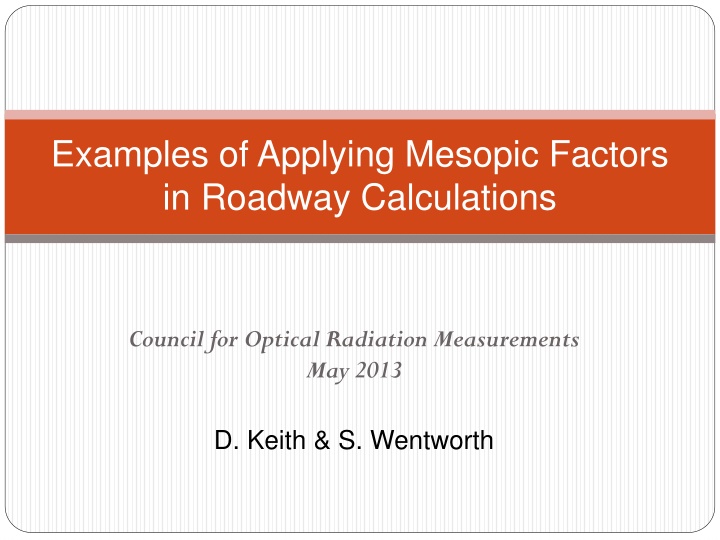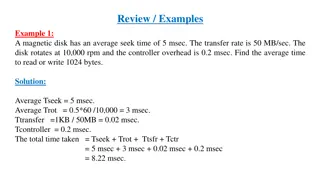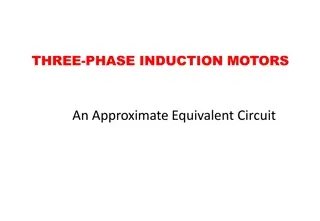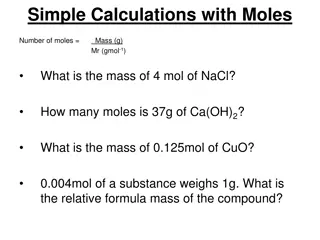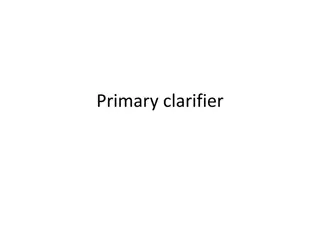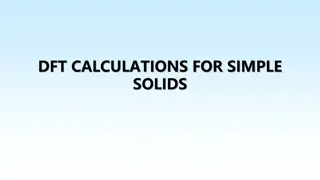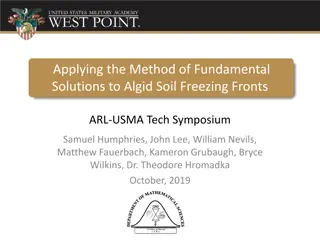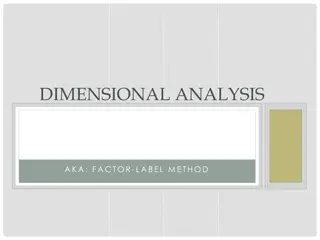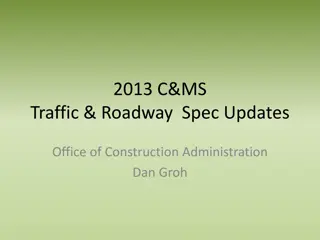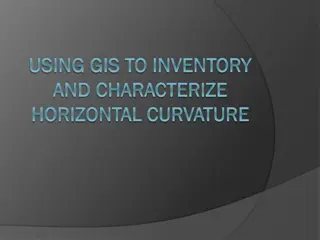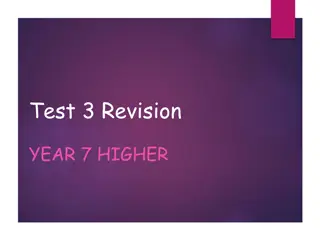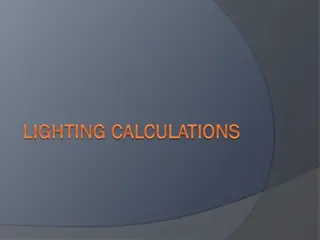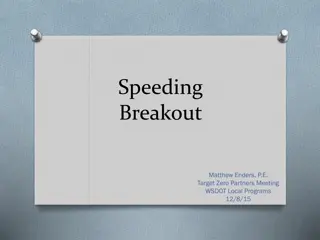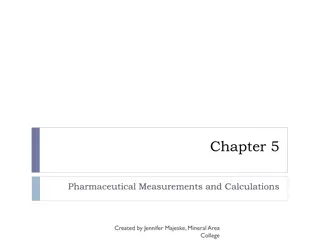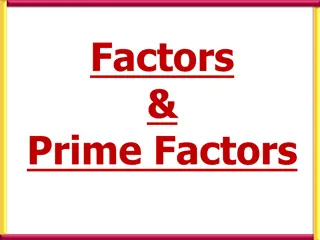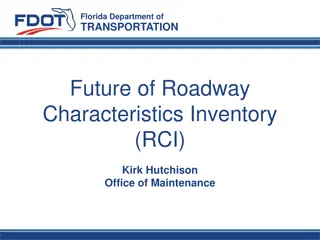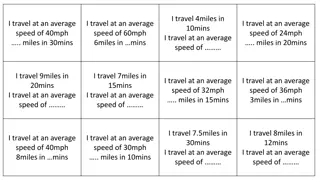Mesopic Factors in Roadway Calculations
Exploring the incorporation of mesopic factors into roadway calculations and how different design luminance ranges and Scotopic/Photopic (S/P) ratios interact with various calculation methods. The discussion includes factors as defined in TM-12 and proposed for RP-8, along with IES RP-8's Mesopic Factors and typical Scotopic/Photopic (S/P) Ratios for various lighting sources. These factors play a crucial role in determining lighting design standards for roadways.
Download Presentation

Please find below an Image/Link to download the presentation.
The content on the website is provided AS IS for your information and personal use only. It may not be sold, licensed, or shared on other websites without obtaining consent from the author.If you encounter any issues during the download, it is possible that the publisher has removed the file from their server.
You are allowed to download the files provided on this website for personal or commercial use, subject to the condition that they are used lawfully. All files are the property of their respective owners.
The content on the website is provided AS IS for your information and personal use only. It may not be sold, licensed, or shared on other websites without obtaining consent from the author.
E N D
Presentation Transcript
Examples of Applying Mesopic Factors in Roadway Calculations Council for Optical Radiation Measurements May 2013 D. Keith & S. Wentworth
Overview What happens when different approaches are used to incorporate mesopic factors into roadway calculations? How do different design luminance ranges & sources Scotopic / Photopic (S/P) ratios interact with calculation methods? CORM 2013 Gaithersburg. MD
Overview: put TM12 into RP-8? >>> CORM 2013 Gaithersburg. MD
Factors as defined in TM-12 Effective Luminance Factor (ELF) defined as ELF = equivalent mesopic luminance photopic luminance - function of photopic luminance & S/P ratio - range: 0.005 cd/m2 to 5 cd/m2 - at 5 cd/m2, factors converge to 1.0 - at 0.005 cd/m2 and lower, factors = S/P ratio ANSI/IES definition of mesopic: 0.034 to 3.4 cd/m2 ( Nomenclature & Definitions .. , ANSI/IES RP-16-05) CORM 2013 Gaithersburg. MD
Factors as proposed for RP-8 Mesopic Factor defined for proposed RP-8 as MF = photopic luminance equivalent mesopic luminance - function of photopic luminance & S/P ratio - tabulated range: 0.3 cd/m2 to 5 cd/m2 - reiterative calculation procedure provided with range extended down to 0.005 cd/m2 - at 5 cd/m2, factors converge to 1.0 this presentation, developed for the Roadway Committee, uses the MF version of these factors so Lmesopic = Lphotopic / Mesopic Factor CORM 2013 Gaithersburg. MD
IES RP-8s Mesopic Factors 1.4 Mesopic 'Luminance' = f(photopic Luminance, S/P ratio) 1.3 1.2 1.1 SP 0.2 SP 0.6 SP 1.0 SP 1.4 SP 1.9 SP 2.4 SP 2.8 1 0.9 0.8 0.7 0.6 0 0.5 1 1.5 photopic Luminance (cd/m2) 2 2.5 3 3.5 4 CORM 2013 Gaithersburg. MD
IES RP-8s Mesopic Factors 1.4 Mesopic 'Luminance' = f(photopic Luminance, S/P ratio) 1.3 1.2 1.1 SP 0.2 SP 0.6 SP 1.0 SP 1.4 SP 1.9 SP 2.4 SP 2.8 1 0.9 0.8 0.7 0.6 0 0.5 1 1.5 photopic Luminance (cd/m2) 2 2.5 3 3.5 4 CORM 2013 Gaithersburg. MD
Typical Scotopic/Photopic (S/P) Ratios CIE Illuminant A CIE Illuminant D65 HPS Mercury Vapor (ctd) Fluorescent (& Induction) 1.1 to 1.8 (2700K to 5000K) Ceramic MH 'Conventional' MH LED (neutral to cool) (sources: CIE and NOAA/National Geophysical Data Center) 1.41 (incandescent at 2856K) 2.46 (daylight at 6500K) 0.6 to 0.7 (2000K to 2200K) 1.2 (3700K) 1.3 to 1.5 (2900K to 3600K) 1.4 to 1.8 (3100K to 4300K) 1.7 to 2.1 (4500K to 6300K) CORM 2013 Gaithersburg. MD
Luminance Values from RP-8 Table 3 Road Conflict Area Lavg Lavg/Lmin Lmax/Lmin Lvmax/Lavg Expressway High 1.0 3 5 0.3 Low 0.6 3.5 6 0.3 Major High 1.2 3 5 0.3 Low 0.6 3.5 6 0.3 Collector High 0.8 3 5 0.4 Low 0.4 4 8 0.4 Local High 0.6 6 10 0.4 Low 0.3 6 10 0.4 CORM 2013 Gaithersburg. MD
Luminances RP-8 Table 3 (cd/m2) Road Conflict Area Lavg Lavg/Lmin Lmax/Lmin Lvmax/Lavg Expressway High 1.0 3 5 0.3 Low 0.6 3.5 6 0.3 Major High 1.2 3 5 0.3 Low 0.6 3.5 6 0.3 0.8 3 5 0.4 Collector High Low 0.4 4 8 0.4 Local High 0.6 6 10 0.4 Low 0.3 6 10 0.4 CORM 2013 Gaithersburg. MD
Luminances RP-8 Table 3 (cd/m2) Road Conflict Area Lavg Lavg/Lmin Lmax/Lmin Lvmax/Lavg 1.0 Expressway High 3 5 0.3 Low 0.6 3.5 6 0.3 Major High 1.2 3 5 0.3 Low 0.6 3.5 6 0.3 Collector High 0.8 3 5 0.4 Low 0.4 4 8 0.4 Local High 0.6 6 10 0.4 Low 0.3 6 10 0.4 CORM 2013 Gaithersburg. MD
Luminances RP-8 Table 3 (cd/m2) Road Conflict Area Lavg Lavg/Lmin Lmax/Lmin Lvmax/Lavg Expressway High 1.0 3 5 0.3 Low 0.6 3.5 6 0.3 Major High 1.2 3 5 0.3 Low 0.6 3.5 6 0.3 Collector High 0.8 3 5 0.4 0.4 Low 4 8 0.4 0.6 Local High 6 10 0.4 0.3 Low 6 10 0.4 CORM 2013 Gaithersburg. MD
Methodologies for Applying Factors Average of all roadway pavement points (Avg) Determine one factor using the mathematical average of photopic values for all roadway pavement calculation points Lavg changes, all other values remain the same Grid treated as having overall adaptation ~ Lavg CORM 2013 Gaithersburg. MD
Methodologies for Applying Factors Each Point Individually (~TM-12) (Pnts) Determine a factor using the photopic luminance value at each roadway pavement calculation point Each value shifts independently: average, maximum, minimum and uniformity ratios Each point is treated as if visibility is solely dependent on the luminance of that point No adaptation level is established CORM 2013 Gaithersburg. MD
Methodologies for Applying Factors Modified Veiling Luminance (LvM) Determine one factor for the pavement luminances using the mathematical average of photopic values for all roadway pavement calculation points (same as Avg) Determine one factor for the veiling luminance using the maximum veiling luminance value Lavg and LvMax each change , separately pavement uniformity ratios remain the same for LvRatio (LvR) use photopic value of average luminance because this is a foveal phenomenon grid treated as having overall adaptation ~ Lavg then compared to adjusted veiling luminance value for ratio LvR CORM 2013 Gaithersburg. MD
High Luminance, Low S/P Ratio Design S/P Ratio Ver: Base Avg Pnts LvM(rd) LvM(vl) Factor 1 1.047 n.a. Lavg 1.017 0.972 0.972 Lmax 2.749 2.627 2.709 Lmin 0.368 0.352 0.340 Lam 2.764 2.764 2.870 Lmm 7.470 7.470 7.971 LvMax 0.306 0.292 0.279 LvR 0.300 0.301 0.287 demo 0.6 1.047 0.972 2.627 0.352 2.764 7.470 1.099 0.279 0.274 CORM 2013 Gaithersburg. MD
Low Luminance, Low S/P Ratio Design S/P Ratio Ver: Base Avg Pnts LvM(rd) LvM(vl) Factor 1 1.074 n.a. Lavg 0.508 0.473 0.475 Lmax 1.374 1.279 1.322 Lmin 0.184 0.171 0.159 Lam 2.761 2.761 2.980 Lmm 7.467 7.467 6.317 LvMax 0.153 0.142 0.134 LvR 0.300 0.301 0.284 demo_low 0.6 1.074 0.473 1.279 0.171 2.761 7.467 1.140 0.134 0.264 CORM 2013 Gaithersburg. MD
High Luminance, High S/P Ratio Design S/P Ratio Ver: Base Avg Pnts LvM(rd) LvM(vl) Factor 1 0.880 n.a. Lavg 1.017 1.156 1.145 Lmax 2.749 3.125 2.880 Lmin 0.368 0.418 0.461 Lam 2.764 2.764 2.486 Lmm 7.470 7.470 6.252 LvMax 0.306 0.348 0.388 LvR 0.300 0.301 0.335 demo 2.4 0.880 1.156 3.125 0.418 2.764 7.470 0.789 0.388 0.381 CORM 2013 Gaithersburg. MD
Low Luminance, High S/P Ratio Design S/P Ratio Ver: Base Avg Pnts LvM(rd) LvM(vl) Factor 1 0.827 n.a. Lavg 0.508 0.614 0.608 Lmax 1.374 1.661 1.518 Lmin 0.184 0.222 0.240 Lam 2.761 2.761 2.530 Lmm 7.467 7.467 6.317 LvMax 0.153 0.185 0.208 LvR 0.300 0.301 0.338 demo_low 2.4 0.827 0.614 1.661 0.222 2.761 7.467 0.737 0.208 0.409 CORM 2013 Gaithersburg. MD
Comparison by Luminance CORM 2013 Gaithersburg. MD
Lavg = 0.5 cd/m2, 0.6 S/P Ratio 140% Lavg Lmax Lmin Lavg/Lmin Lmax/Lmin Lvmax Lvmax/Lavg 130% 120% 110% 100% 90% 80% Base Adjusted Average Adjusted Points Adjusted LvModified CORM 2013 Gaithersburg. MD
Lavg = 1.0 cd/m2, 0.6 S/P Ratio 140% Lavg Lmax Lmin Lavg/Lmin Lmax/Lmin Lvmax Lvmax/Lavg 130% 120% 110% 100% 90% 80% Base Adjusted Average Adjusted Points Adjusted LvModified CORM 2013 Gaithersburg. MD
Lavg = 0.5 cd/m2, 2.4 S/P Ratio 140% Lavg Lmax Lmin Lavg/Lmin Lmax/Lmin Lvmax Lvmax/Lavg 130% 120% 110% 100% 90% 80% Base Adjusted Average Adjusted Points Adjusted LvModified CORM 2013 Gaithersburg. MD
Lavg = 1.0 cd/m2, 2.4 S/P Ratio 140% Lavg Lmax Lmin Lavg/Lmin Lmax/Lmin Lvmax Lvmax/Lavg 130% 120% 110% 100% 90% 80% Base Adjusted Average Adjusted Points Adjusted LvModified CORM 2013 Gaithersburg. MD
Comparison by S/P Ratio Luminance at 0.5 cd/m2 CORM 2013 Gaithersburg. MD
Lavg = 0.5 cd/m2, 0.6 S/P Ratio 140% Lavg Lmax Lmin Lavg/Lmin Lmax/Lmin Lvmax Lvmax/Lavg 130% 120% 110% 100% 90% 80% Base Adjusted Average Adjusted Points Adjusted LvModified CORM 2013 Gaithersburg. MD
Lavg = 0.5 cd/m2, 0.9 S/P Ratio 140% Lavg Lmax Lmin Lavg/Lmin Lmax/Lmin Lvmax Lvmax/Lavg 130% 120% 110% 100% 90% 80% Base Adjusted Average Adjusted Points Adjusted LvModified CORM 2013 Gaithersburg. MD
Lavg = 0.5 cd/m2, 1.1 S/P Ratio 140% Lavg Lmax Lmin Lavg/Lmin Lmax/Lmin Lvmax Lvmax/Lavg 130% 120% 110% 100% 90% 80% Base Adjusted Average Adjusted Points Adjusted LvModified CORM 2013 Gaithersburg. MD
Lavg = 0.5 cd/m2, 1.4 S/P Ratio 140% Lavg Lmax Lmin Lavg/Lmin Lmax/Lmin Lvmax Lvmax/Lavg 130% 120% 110% 100% 90% 80% Base Adjusted Average Adjusted Points Adjusted LvModified CORM 2013 Gaithersburg. MD
Lavg = 0.5 cd/m2, 1.7 S/P Ratio 140% Lavg Lmax Lmin Lavg/Lmin Lmax/Lmin Lvmax Lvmax/Lavg 130% 120% 110% 100% 90% 80% Base Adjusted Average Adjusted Points Adjusted LvModified CORM 2013 Gaithersburg. MD
Lavg = 0.5 cd/m2, 2.0 S/P Ratio 140% Lavg Lmax Lmin Lavg/Lmin Lmax/Lmin Lvmax Lvmax/Lavg 130% 120% 110% 100% 90% 80% Base Adjusted Average Adjusted Points Adjusted LvModified CORM 2013 Gaithersburg. MD
Lavg = 0.5 cd/m2, 2.4 S/P Ratio 140% Lavg Lmax Lmin Lavg/Lmin Lmax/Lmin Lvmax Lvmax/Lavg 130% 120% 110% 100% 90% 80% Base Adjusted Average Adjusted Points Adjusted LvModified CORM 2013 Gaithersburg. MD
Comparison by Methodology Luminance at 0.5 cd/m2 CORM 2013 Gaithersburg. MD
Adjusted Using Average Method 140% Lavg Lmax Lmin Lavg/Lmin Lmax/Lmin Lvmax Lvmax/Lavg 130% 120% 110% 100% 90% 80% SPR 0.6 SPR 0.9 SPR 1.1 SPR 1.4 SPR 1.7 SPR 2.0 SPR 2.4 CORM 2013 Gaithersburg. MD
Adjusted Using Point Method 140% Lavg Lmax Lmin Lavg/Lmin Lmax/Lmin Lvmax Lvmax/Lavg 130% 120% 110% 100% 90% 80% SPR 0.6 SPR 0.9 SPR 1.1 SPR 1.4 SPR 1.7 SPR 2.0 SPR 2.4 CORM 2013 Gaithersburg. MD
Adjusted LvModified Method 140% Lavg Lmax Lmin Lavg/Lmin Lmax/Lmin Lvmax Lvmax/Lavg 130% 120% 110% 100% 90% 80% SPR 0.6 SPR 0.9 SPR 1.1 SPR 1.4 SPR 1.7 SPR 2.0 SPR 2.4 CORM 2013 Gaithersburg. MD
Thanks to CORM! & special thanks to Scott Wentworth who helped make this presentation happen References: Spectral Effects of Lighting on Visual Performance at Mesopic Lighting Levels , IES TM-12-12 American National Standard Practice for Roadway Lighting , ANSI/IES RP-8-00 Nomenclature and Definitions for Illumination Engineering , ANSI/IES RP-16-05 Laboratory Spectra , Earth Observation Group, National Geophysical Data Center/NOAA any questions? CORM 2013 Gaithersburg. MD
